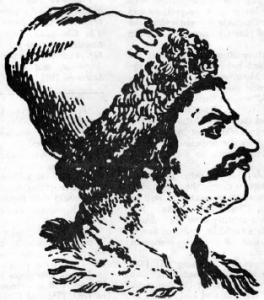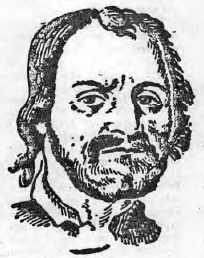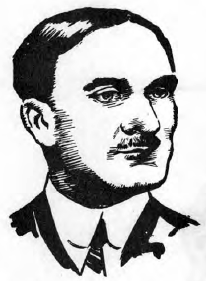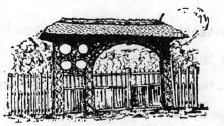Main Body
2. Historical Background
The Romanians are descendants of the old Roman conquerors and colonizers of Dacia, the territories north of the Danube, between the Tisa and Dniester Rivers.
The Dacians, a rustic and warlike people of Thracian origin, lived in and around the Carpathian Mountains. In the first century B.C. they extended their power under their king, Boirebista, as far as the regions of Moldova as we know it today, and the Black Sea.
The administration of the Roman Empire was much annoyed by the plundering intrusions of these troublesome neighbors and therefore sent a Roman army from Rome to subdue the Dacians. Emperor Trajan in two successive campaigns waged in the years 101-102 and 105-106 A.D. completely crushed the Dacians in the very heart of their country.
As history reveals, the policy of the Romans was to colonize every foreign country they had conquered by war in order that the conquest might last and a further expansion of the Roman Empire be possible. This policy was also followed by Trajan with the Dacians by colonizing their land with Roman soldiers and Roman officials. In fact, the entire administration of Dacia was Roman. Besides the Roman legions and officials, another element came to Dacia: Roman merchants who usually followed their armies.
Tired of fighting the rebellious Dacians and the barbaric Goths who invaded the province from the east, in the year 271 the Roman Emperor Marcus Aurelius decided to abandon Dacia.
The more than 100 years of Roman occupation had a profound effect on the population of Dacia. Possessing a superior culture to that of the Dacians, the Roman legionnaires, officials and merchants could easily impose their Latin language on the Dacians. Intermarriage of the Roman soldiers with Dacian women also contributed to the final Romanization of the Dacian territories.
The spreading of the Slavs into Dacia and south across the Danube, from the seventh century onward, divided the mass of these eastern Latins into many groups and entirely severed their contacts with the peoples of western Europe.
The political development of the Romanians in the Romanized regions of Dacia was strongly curtailed by the settling of the Magyars in Pannonia at the end of the ninth century. When the authority of the Magyar chieftains, who had become apostolic kings under the Pope, later extended into the Transylvanian highlands, the Romanian chieftains, known as “knezi” and “voevods” could no longer maintain themselves in power. The Romanians of Transylvania, as Dacia became known, remained under the growing Magyar clans and principalities which later developed into a powerful Magyar state.
In 1300 the Romanians succeeded forming their first state at Arges, at the foot of the Carpathian Mountains. Later on, similar Romanian states and principalities were established in Oltenia, Moldova, Bessarabia, Bucovina and Dobrudja, with Romanian domni or princes as their leaders. Here we find folk heroes like Stephen the Great, the Vlads, Dracul (Devil) and Tsepes (Impaler).
In the course of centuries these Romanian political units fell under different foreign rules such as the Russians, Turks and Greeks. The foreign yoke was partially thrown off in 1862 when Alexander Cuza united Moldova and Muntenia in a single state called “Romania.” In 1877, under King Carol of Hohenzollern, Romania emerged from the Turkish suzerainty and became a fully independent state.
The Romanians of Transylvania, however, continued to live under Magyar rule; the Romanians of Bucovina under the Austrian rule and those in Bessarabia under the Russian. Although living under foreign rule, these Romanians preserved their language, customs, attire, religion and traditions for centuries.
In World War I, the Kingdom of Romania fouqht on the side of the western allies against the Central Powers of Germany and Austria Hungary. When victory came at the end of World War I, the Romanians of Transylvania, Bessarabia, Bucovina and Dobrudja voted to join the “Old Romanian Kingdom” and unified — Greater Romania became a reality.
At the end of World War II, Romania lost parts of Bucovina, all of Bessarabia and parts of Dobrudja to the Soviet Empire and to the Bulgarians. On August 23, 1944, the monarchy was abolished in Romania and a Communist dominated government assumed power. The country is now officially called the Socialist Republic of Romania. It is bounded by the Union of Soviet Socialist Republics, the Black Sea, Bulgaria, Yugoslavia and Hungary. The Danube flows along the southern border and through Eastern Romania into the Black Sea.


Alba Iulia
Alba Iulia, located in tha very center of Transylvania, has been, for centuries, the spiritual and historic center of Romanian aspirations for freedom and the union of all Romanians, wherever they may have lived.
When Michael the Brave, united temporarily all Romanian territories under his flag four hundred years ago, Alba Iulia was chosen by him to be his capital.
It was at Alba Iulia that, on December 1, 1918, more than 100,000 Romanians came from all parts of Transylvania and voted unanimously to unite Transylvania with the “mother country,” the Kingdom of Romania. And it was at Alba Iulia that King Ferdinand and Queen Marie were crowned first rulers of the United Greater Romania.
The Romanian Peasant Revolt of 1784 in Transylvania
By THEODORE ANDRICA[1]
Of all the revolutions Romanians made against their oppressors none was more heroic in its proportions and less known outside Romania than the uprising of Horia, Closea and Crisan in 1784.
These three Romanian peasants led a short lived but bloody revolt in the “Western Mountains” of Transylvania, a countryside known as the “Land of the Motzi,” against their ruthless Magyar noble rulers. The three peasant leaders and their several thousands followers were defeated not by the Hungarians but by the Imperial Armies of Austria which came to the Magyars’ aid.
It is doubtful if any other Romanian historical figures caught the imagination of the Romanian peasantry as well as did Haria, Closca and Crisan. For more than a century after their death, their pictures could be found in nearly every peasant Romanian home in Transylvania.
The Romanian uprising of 1784 against the Hungarian feudal lords was different from any other Romanian revolt, for it was initiated and led not by intellectuals but by the peasantry which had little or no contact with the outside world.
In those days in Transylvania as well as in other parts of the territories ruled by the Hungarians, the land owning nobility had the power of life and death over the serfs.
The Romanians fared especially bad. Although they were in preponderant majority in Transylvania, the Romanians were considered neither a national nor a religious group.
“The Romanians are tolerated only at the pleasure of the Prince and the Nobles,” a contemporary Hungarian document states.
Horia’s revolt was both social and national in character. This great peasant leader and his followers realized that only after freeing themselves from serfdom could they fight for an independent, Romanian existence in Transylvania.
Horia hoped to take advantage of the antagonism which existed between Francis II, the Austrian emperor, and the Hungarian nobles. Horia visited in Vienna four times and was received by the Austrian emperor three times, in 1780, 1782 and 1784.
Horia returned from Vienna early in 1784 feeling certain that the emperor would not interfere with his eventual revolt against the Hungarian nobles in Transylvania since he made it clear to the Emperor that his revolt would not be against Austria.
Thus encouraged by the emperor, Horia and his followers began their armed revolt against their Hungarian feudal lord-oppressors on Oct. 31, 1784 in the village of Mesteacan, near Brad, county of Hunedoara.


A group of Romanian peasants led by George Crisan began a march to Alba-Iulia, the “citadel of Transylvania.” At Curechi the peasants encountered a group of Hungarian soldiers. A battle followed and the Hungarian soldiers were annihilated. Thus the revolt began.
The uprising spread like wildfire and thousands of peasants from four counties eventually joined Horia, Closca and Crisan who immediately took charge of the struggle, Horia becoming the principal leader. Before the revolt was stopped Horia became a legendary figure and thousands of peasants called him “emperor of Dacia,” as Transylvania was called earlier.
Horia’s peasants attacked and sacked the Hungarian nobles’ estates in Criscior, Ribita, Brad and other localities. In five days the entire Zarand countryside was in the rebels’ hands. The Hungarian nobles, those who could escape, fled to the larger cities, Deva, Arad, to the province of Banat and to northern Transylvania. In two weeks the uprising spread to the counties of Bihor and to the vicinity of Cluj.
Meanwhile the Austrian emperor and his advisers changed their minds about Horia’s revolt. They decided to stop it before it enveloped all the lands of Transylvania. So far Horia succeeded only in parts in and near the Western Mountains. (They are situated north of the river Muras, near the 1939 Romanian-Hungarian border.)
Emperor Francis II offered Horia and his followers peace and rectification of some of their wrongs if they returned to their homes. An armistice was made between Horia and the Emperor’s forces, a mistake which later proved disastrous for Horia.
The imperial armies began to surround the localities where Horia’s peasant soldiers previously barred entrance. Some of the peasants, thinking the fight had ceased and that they had won, returned to their mountain homes.
On Dec. 14, 1784 Horia “demobilized” his forces. Accompanied by Closca and less than 100 peasants he retreated into the forest of Scoracet, county of Huedin. In the spring Horia was to go to Vienna to tell the emperor again that he did not wish to fight the Imperial armies, that his fight was only against the Magyar lords.
The emperor, meantime, placed a prize of 300 gold Florins on Horia’s head which eventually led to the capture of Horia and Closca by the emperor’s soldiers who were led to the rebel’s forest hiding place by seven erstwhile peasant soldiers.
Crisan, the third leader, who often fought independently of Horia, continued his guerrilla war in various parts of the Transylvania Western Mountains but he, too, was captured a month after Horia and Closca had fallen prisoner.
All three were taken to the Fortress of Alba Iulia. There they were tried in great secrecy by three military officers. Crisan committed suicide in prison but his sentence, too, was carried out later as ruthlessly as if he had lived.
Horia and Closca were first led — in heavy chains — through the various villages so that the peasants could see that they were really captured. Then on Feb. 26, 1785 they were condemned to:
“…have all their bones broken on the Wheel, starting with the legs, and beginning with Closca. Thus killed their bodies to be split in quarters; their heads and bodies to be tied on wheels and placed on public places in those parts of the countryside where they ‘mostly displayed their cruelty’; their hearts and intestines be buried on the execution grounds…”
On Monday, Feb. 18, 1785, the two were executed before 2515 Romanian peasants who were brought forcibly from 419 villages to witness the brutal execution.
Crisan (despite his suicide) was sentenced to have his head severed and then placed on a pole in front of his home in the village of Carpinis; his body to be quartered, tied to a wheel and be displayed at Carpinis, Bucium and Brad.
Thus died the three Romanian peasant leaders for trying to escape serfdom and to liberate their fellow peasants from the rule of the ruthless Hungarian nobility.
Their death was not useless. As a direct consequence of Horia’s revolt, Emperor Francis II on Aug. 25, 1785 abolished serfdom in Transylvania although the calvary of the Romanian ethnical group was by no means ended.
The story would not be complete without a short biographical sketch of the three peasant revolutionary leaders.
The correct name of Horia was Vasile Nicola Ursu, nicknamed Horia because he loved to sing Romanian folksongs called “Hore” and “Doine.” He was born in the village of Albac around 1730 and was about 54 years old at the time of his revolt. He spoke German.
He was a dark complexioned and melancholy man with eager and penetrating eyes. He wore peasant clothes in the style of those from Zlatna, a fur cap called in Romanian “kachiula.” He had two sons, Ioan, born in 1765 and Luca, born in 1768.
Closca was Horia’s constant companion. His real name was Ioan Oarga. He was born in Carpinis, the domain of Zlatna and was about 40 years old at the time of the revolution. He was short of stature, wore the customary peasant attire and “kachiula,” but he augmented his costume with a sheep-skin coat.
Crisan, the third leader of the uprising — his forces started the revolt — was a native of the village of Vaca. He was the son of Peter Golda but after his father’s death he was named Giurgiu Marcul because he lived with his grandfather on his mother’s side, who was a priest in Strapti-Bulzesti.
Crisan previously had served with the Austrian armies and therefore had some idea of military tactics. At the time of the revolt he was 52 years old.


Theodore Andrica is a Nieman Fellow at Harvard University, Cambridge, Mass. He is on leave of absence from The Cleveland Press where he is Nationalities Editor for the past 17 years. Mr. Andrica is a native of Radna-Arad, Romania, and came to the United States in 1921.
Dr. Iuliu Maniu

Known as the greatest exponent of democracy for Romania, Dr. Iuliu Maniu was the hero not only of the liberty loving Romanians in the Old Country, but also as a hero to the Romanians living in the United States. A Romanian fraternal lodge in Canton, Ohio bears his name.
Born in 1873 to an intellectual family of magistrates in Salaj County, in the north-western corner of Transylvania, young Maniu received his education in the then existing Romanian schools in Transylvania and nis law education at the Universities of Budapest and Vienna.
In his 30’s, Dr. Maniu was elected a deputy in the Hungarian parliament of Budapest. Until 1918, Transylvania was ruled by Hungary and the Magyar rule was quite harsh on the non-Magyar ethnic minorities living in Hungary. Dr. Maniu soon became the most outspoken opponent of the Magyar treatment of the minorities living in Hungary.
When the Austro-Hungarian empire collapsed in October, 1918, Dr. Maniu was one of the principal leaders of the movement to separate Transylvania from Hungary. Early in 1919 he was elected president of the Directing Council of Transylvania which took over the power in Transylvania following the mammoth People’s Assembly vote at Alba Iulia on December 1, 1918.
One hundred thousand delegates from all parts of Transylvania assembled in the historic capital of this province and voted unanimously to unite Transylvania with the “mother country,” the Kingdom of Romania. Dr. Maniu was the principal organizer of the great and historical meeting.
As leader of the National Peasant Party, Dr. Maniu became prime minister of Romania in 1928 and served successively in that capacity several times. King Ferdinand having died, he was succeeded by his son Carol II who did not particularly favor the deeply religious, ascetic Dr. Maniu and the latter’s democratic policies. In time, the two had a definite falling out. Dr. Maniu openly opposed the king’s friendship with Magda Lupescu.
When Romanian governments and the king toyed with the idea of making Romania an ally of Nazi Germany, Dr. Maniu was one of the principal opponents of such a move. After King Carol renounced Germany, even under the reign of King Michai, successor to the Romanian throne.
From the very outset of World War II, when Romania was allied with Nazi Gennany in the war against Russia, Dr. Maniu continued his opposition to Nazi Germany. During the war he sent representatives to negotiate with the Western Allies. During the dictatorship of Marshall Antonescu, Dr. Maniu continued advocating democratic means for the problems of Romania.
Following the victories of the Soviet Union, Romania was occupied by Soviet troops. Dr. Maniu appealed to the Allies to restrain the Soviets from plundering Romania. Thus, Dr. Maniu was considered an implacable enemy of the Soviet rule.
To eliminate Dr. Maniu from the political scene, the Soviet dominated Communist government of Romania staged a show trial in which Dr. Maniu was accused of attempting to overthrow the Communist government. At the end of a four day trial, on November 11, 1947, he was sentenced to life imprisonment.
In spite of his advanced age and his precarious health, Dr. Maniu was given harsh treatment by the Communist prison authorities and he was reported dead in a prison in Sighetul Marmatiei around 1955. Romanian authorities, to this day, refuse to indicate the precise place where Dr. Maniu was buried.

- Andrica, Theodore, "The New Pioneer," The Romanian Peasant Revolt of 1784 in Transylvania, Vol. 2, No. 2, April, 1944. ↵
